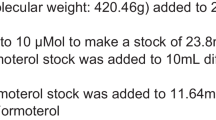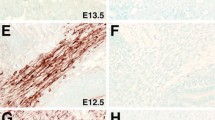Abstract
Androgens have anabolic actions in skeletal muscle and could potentially act to: (a) increase proliferation of myoblasts; (b) delay differentiation to myotubes; and (c) induce protein accretion in post-proliferative myofibers. To identify the site of androgens action, we investigated the proliferative response of the C2C12 mouse myoblast cell line to testosterone and dihydrotestosterone (DHT) treatment. Neither androgens affected cell proliferation after up to 7 days treatment, nor was there a synergistic effect of androgens on the proliferative response of C2C12 cells to IGF-I treatment. However, proliferating C2C12 cells expressed 0.1% of the level of androgen receptor (AR) mRNA found in adult mouse gastrocnemius muscle (p<0.01). Therefore, we generated mouse C2C12 myoblast cell lines stably transfected with the mouse AR cDNA driven by the SV40 promoter (C2C12-AR). C2C12-AR cell proliferation, differentiation, and protein content were analyzed in response to androgen treatment. Our data demonstrated that androgen treatment does not alter either proliferation rate or differentiation rate of C2C12-AR cells. However, treatment of differentiated C2C12-AR myotubes with 100 nM DHT for 3 days caused a 20% increase in total protein content vs vehicle treatment (p<0.05). This effect was not observed in control C2C12 cells transfected with empty vector. These data suggest that androgens act via the AR to upregulate myotube protein content. This model cell line will be useful to further investigate the molecular mechanisms via which androgens regulate protein accretion.
Similar content being viewed by others
References
MacLean HE, Warne GL, Zajac JD. Localization of functional domains in the androgen receptor. J Steroid Biochem Mol Biol 1997, 62: 233–42.
Hiort O. Androgens and puberty. Best Pract Res Clin Endocrinol Metab 2002, 16: 31–41.
Bhasin S, Storer TW, Berman N, et al. The effects of supraphysiologic doses of testosterone on muscle size and strength in normal men. N Engl J Med 1996, 335: 1–7.
Brodsky IG, Balagopal P, Nair KS. Effects of testosterone replacement on muscle mass and muscle protein synthesis in hypogonadal men—a clinical research center study. J Clin Endocrinol Metab 1996, 81: 3469–75.
Bhasin S, Woodhouse L, Casaburi R, et al. Older men are as responsive as young men to the anabolic effects of graded doses of testosterone on the skeletal muscle. J Clin Endocrinol Metab 2005, 90: 678–88.
Bhasin S, Storer TW, Berman N, et al. Testosterone replacement increases fat-free mass and muscle size in hypogonadal men. J Clin Endocrinol Metab 1997, 82: 407–13.
Katznelson L, Finkelstein JS, Schoenfeld DA, Rosenthal DI, Anderson EJ, Klibanski A. Increase in bone density and lean body mass during testosterone administration in men with acquired hypogonadism. J Clin Endocrinol Metab 1996, 81: 4358–65.
Snyder PJ, Peachey H, Hannoush P, et al. Effect of testosterone treatment on body composition and muscle strength in men over 65 years of age. J Clin Endocrinol Metab 1999, 84: 2647–53.
Ferrando AA, Sheffield-Moore M, Yeckel CW, et al. Testosterone administration to older men improves muscle function: molecular and physiological mechanisms. Am J Physiol Endocrinol Metab 2002, 282: E601–7.
Griggs RC, Kingston W, Jozefowicz RF, Herr BE, Forbes G, Halliday D. Effect of testosterone on muscle mass and muscle protein synthesis. J Appl Physiol 1989, 66: 498–503.
Bhasin S, Woodhouse L, Casaburi R, et al. Testosterone dose-response relationships in healthy young men. Am J Physiol Endocrinol Metab 2001, 281: E1172–81.
Axell AM, MacLean HE, Plant DR, et al. Continuous testosterone administration prevents skeletal muscle atrophy and enhances resistance to fatigue in orchidectomized male mice. Am J Physiol Endocrinol Metab 2006, 291: E506–16.
Sheffield-Moore M, Urban RJ, Wolf SE, et al. Short-term oxandrolone administration stimulates net muscle protein synthesis in young men. J Clin Endocrinol Metab 1999, 84: 2705–11.
Mauras N, Hayes V, Welch S, et al. Testosterone deficiency in young men: marked alterations in whole body protein kinetics, strength, and adiposity. J Clin Endocrinol Metab 1998, 83: 1886–92.
Joubert Y, Tobin C, Lebart MC. Testosterone-induced masculinization of the rat levator ani muscle during puberty. Dev Biol 1994, 162: 104–10.
Sinha-Hikim I, Cornford M, Gaytan H, Lee ML, Bhasin S. Effects of testosterone supplementation on skeletal muscle fiber hypertrophy and satellite cells in community-dwelling older men. J Clin Endocrinol Metab 2006, 91: 3024–33.
Benjamin CL, Jenster G, Piedrahita JA. Use of artificial androgen receptor coactivators to alter myoblast proliferation. J Steroid Biochem Mol Biol 2004, 91: 111–9.
Lee DK. Androgen receptor enhances myogenin expression and accelerates differentiation. Biochem Biophys Res Commun 2002, 294: 408–13.
Florini JR, Ewton DZ, Coolican SA. Growth hormone and the insulin-like growth factor system in myogenesis. Endocr Rev 1996, 17: 481–517.
Urban RJ, Bodenburg YH, Gilkison C, et al. Testosterone administration to elderly men increases skeletal muscle strength and protein synthesis. Am J Physiol 1995, 269: E820–6.
Gayan-Ramirez G, Rollier H, Vanderhoydonc F, Verhoeven G, Gosselink R, Decramer M. Nandrolone decanoate does not enhance training effects but increases IGF-I mRNAin rat diaphragm. J Appl Physiol 2000, 88: 26–34.
Sahlin L, Norstedt G, Eriksson H. Androgen regulation of the insulin-like growth factor-I and the estrogen receptor in rat uterus and liver. J Steroid Biochem Mol Biol 1994, 51: 57–66.
Hobbs CJ, Plymate SR, Rosen CJ, Adler RA. Testosterone administration increases insulin-like growth factor-I levels in normal men. J Clin Endocrinol Metab 1993, 77: 776–9.
Veldhuis JD, Metzger DL, Martha PM Jr, et al. Estrogen and testosterone, but not a nonaromatizable androgen, direct network integration of the hypothalamo-somatotrope (growth hormone)-insulin-like growth factor I axis in the human: evidence from pubertal pathophysiology and sex-steroid hormone replacement. J Clin Endocrinol Metab 1997, 82: 3414–20.
Giannoulis MG, Sonksen PH, Umpleby M, et al. The effects of growth hormone and/or testosterone in healthy elderly men: a randomized controlled trial. J Clin Endocrinol Metab 2006, 91: 477–84.
Thompson SH, Boxhorn LK, Kong WY, Allen RE. Trenbolone alters the responsiveness of skeletal muscle satellite cells to fibroblast growth factor and insulin-like growth factor I. Endocrinology 1989, 124: 2110–7.
Jones ME, Boon WC, Proietto J, Simpson ER. Of mice and men: the evolving phenotype of aromatase deficiency. Trends Endocrinol Metab 2006, 17: 55–64.
Matsumine H, Hirato K, Yanaihara T, Tamada T, Yoshida M. Aromatization by skeletal muscle. J Clin Endocrinol Metab 1986, 63: 717–20.
Glenmark B, Nilsson M, Gao H, Gustafsson JA, Dahlman-Wright K, Westerblad H. Difference in skeletal muscle function in males vs. females: role of estrogen receptor-β. Am J Physiol Endocrinol Metab 2004, 287: E1125–31.
van Heuvel M, Bosveld IJ, Luyten W, Trapman J, Zwarthoff EC. Transient expression of murine interferon-alpha genes in mouse and monkey cells. Gene 1986, 45: 159–65.
Notini AJ, McManus JF, Moore A, et al. Osteoblast deletion of exon 3 of the androgen receptor gene results in trabecular bone loss in adult male mice. J Bone Miner Res 2007, 22: 347–56.
Notini AJ, Davey RA, McManus JF, Bate KL, Zajac JD. Genomic actions of the androgen receptor are required for normal male sexual differentiation in a mouse model. J Mol Endocrinol 2005, 35: 547–55.
MacLean HE, Chiu WM, Ma C, et al. Afloxed allele of the androgen receptor gene causes hyperandrogenization in male mice. Physiol Genomics 2008, Jan 2; doi:10.1152/physiolgenomics.00260.2007.
Livak KJ, Schmittgen TD. Analysis of relative gene expression data using real-time quantitative PCR and the 2(ΔΔ-C(T)) Method. Methods 2001, 25: 402–8.
Janssen T, Darro F, Petein M, et al. In vitro characterization of prolactin-induced effects on proliferation in the neoplastic LNCaP, DU145, and PC3 models of the human prostate. Cancer 1996, 77: 144–9.
Sinha-Hikim I, Roth SM, Lee MI, Bhasin S. Testosterone-induced muscle hypertrophy is associated with an increase in satellite cell number in healthy, young men. Am J Physiol Endocrinol Metab 2003, 285: E197–205.
Powers ML, Florini JR. A direct effect of testosterone on muscle cells in tissue culture. Endocrinology 1975, 97: 1043–7.
Kamanga-Sollo E, Pampusch MS, Xi G, White ME, Hathaway MR, Dayton WR. IGF-I mRNA levels in bovine satellite cell cultures: effects of fusion and anabolic steroid treatment. J Cell Physiol 2004, 201: 181–9.
Doumit ME, Cook DR, Merkel RA. Testosterone up-regulates androgen receptors and decreases differentiation of porcine myogenic satellite cells in vitro. Endocrinology 1996, 137: 1385–94.
Ferrando AA, Tipton KD, Doyle D, Phillips SM, Cortiella J, Wolfe RR. Testosterone injection stimulates net protein synthesis but not tissue amino acid transport. Am J Physiol 1998, 275: E864–71.
Joubert Y, Tobin C. Testosterone treatment results in quiescent satellite cells being activated and recruited into cell cycle in rat levator ani muscle. Dev Biol 1995, 169: 286–94.
Kadi F, Eriksson A, Holmner S, Thornell LE. Effects of anabolic steroids on the muscle cells of strength-trained athletes. Med Sci Sports Exerc 1999, 31: 1528–34.
Chen Y, Zajac JD, MacLean HE. Androgen regulation of satellite cell function. J Endocrinol 2005, 186: 21–31.
Nnodim JO. Testosterone mediates satellite cell activation in denervated rat levator ani muscle. Anat Rec 2001, 263: 19–24.
Lee DH, Goldberg AL. Proteasome inhibitors: valuable new tools for cell biologists. Trends Cell Biol 1998, 8: 397–403.
Prescott J, Coetzee GA. Molecular chaperones throughout the life cycle of the androgen receptor. Cancer Lett 2006, 231: 12–9.
Author information
Authors and Affiliations
Corresponding author
Additional information
These authors contributed equally to this work.
Rights and permissions
About this article
Cite this article
Chen, Y., Lee, N.K.L., Zajac, J.D. et al. Generation and analysis of an androgen-responsive myoblast cell line indicates that androgens regulate myotube protein accretion. J Endocrinol Invest 31, 910–918 (2008). https://doi.org/10.1007/BF03346441
Accepted:
Published:
Issue Date:
DOI: https://doi.org/10.1007/BF03346441




